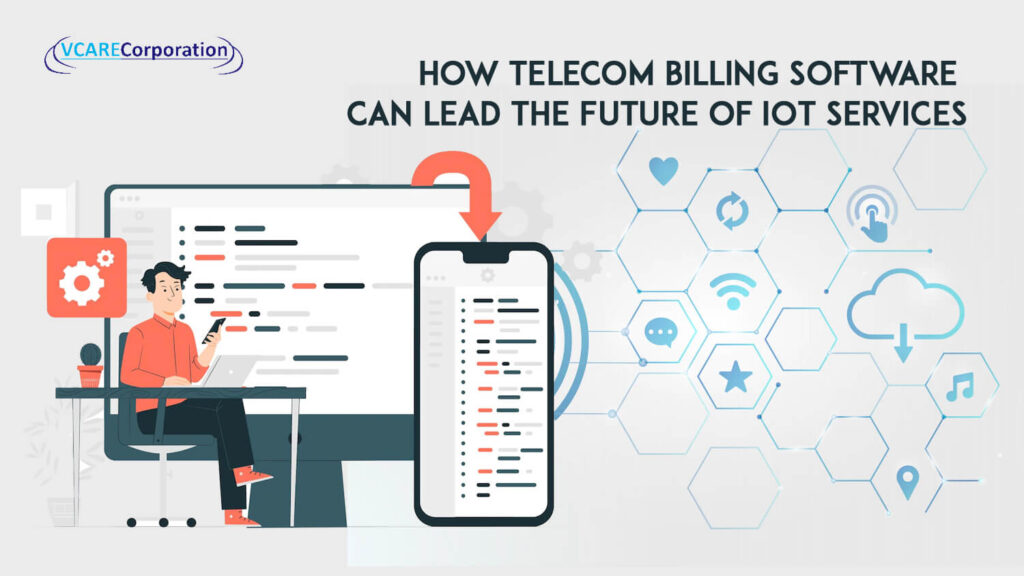In recent years, the Internet of Things (IoT) has evolved from a concept to a widely used solution in households and businesses. According to predictions, 25.4 billion IoT devices will be on the market by 2030, up from 10 billion in 2021. IoT devices can connect to more extensive networks, which gives them a wide range of possibilities. Some sectors utilizing IoT technologies are utilities, retail, and agriculture.
The telecoms sector, though, stands to gain the most because IoT is so dependent on telecommunications providers. New mobile IoT apps and services provide excellent development potential for mobile operators. IoT is expected to bring approximately $1.8 trillion in revenue for mobile network operators by 2026. This will be a significant boost because telecom billing software income has been increasing recently.
Network providers now have to make communication more straightforward for people and technology because of the Internet of Things. To monetize IoT solutions, telecom companies must provide innovative services and applications. Adopting SaaS, BaaS, and PaaS models can help businesses run more efficiently and provide their consumers with better services. Decide which IoT applications will benefit you the most as a telecom company, and focus on those.
IoT applications in the Telecom billing software
The lucrative IoT in telecom presents a once-in-a-lifetime chance to monetize their data and expand into other industries, delivering projects and services beyond network connectivity. On the other hand, call center outsourcing vendors won’t be able to become IoT leaders on their own.

By partnering with other businesses in the IoT ecosystem, telecom billing software solutions can investigate new opportunities and IoT use cases in telecom, enabling them to build a more extensive range of services based on their distinctive assets. Many businesses, from manufacturing to healthcare, can leverage telecom services, including intelligent networks, data analytics, IoT platforms, billing, CRM, and cloud services.
Future of IoT and value-added services in the telecom sector
After establishing themselves as credible connectivity providers, telcos have reached a tipping point. Essential resources, including established telecommunications infrastructure, impressive data sets, and 5G-enabled connectivity, are essential for CSPs.
As the breadth and profitability of traditional telecom services have reached a plateau, this is done to regain the lead in the communications value chain. But no telco can realistically choose to take on the competition on its own.
The Internet of Things offers cross-industry, lucrative business opportunities, and telecom carriers must build an ecosystem of dependable and cutting-edge technology partners to compete with OTTs and benefit from it. CSPs must establish partnerships with platform and software vendors to open new revenue streams based on current IoT services and clear the way for sustainable growth.
What to Look for in Software for Telecom Billing
Today, top call center outsourcing companies provide telecom billing services.
First and foremost, before selecting any telecom billing software, it is crucial to evaluate each option critically. Gathering requirements and conducting feasibility studies are essential to ensure the system fits your organization’s needs. It would be best if you also got a thorough demonstration of the product. You can then become familiar with all the solution elements and decide whether it will function adequately in practical circumstances.
Here are some things to think about.
Is the entire system scalable? What about the scalability of billing software?
Is adding or configuring new modules and capabilities simple enough?
For the system to adapt to the needs of your organization and the most current industry rules, vertical and horizontal scalability is crucial. Avoiding unreasonably long configuration and improvement times requires modularization.
The telecom billing software should include real-time and session-based charging, flexible pricing, and various payment methods—these characteristics aid telecom providers in reducing time-to-market and enhancing customer experience.
Can the system be combined with software from other companies?
You may link it with many CRMs, enterprise resource planners (ERP), gateways, and other potential solutions with good API coverage.
The user experience is a concern. Is it simple to use and learn the system?
It needs to be simple to understand and have a low learning curve. Additionally, you’ll want to confirm that it has some creative CRM capabilities that can support the development of long-lasting client relationships.
Look for user interfaces that are well-designed, clear, and intuitive. When the user interface is simple to use and pick up, your customers and employees enjoy it. Don’t forget to take pricing alternatives into account. The system can be purchased as a one-time licensing fee or as a SaaS.
Contact center outsourcing services will have variable pricing and consider deployment alternatives. Cybersecurity is a crucial component to look for in a telecom billing solution. The design needs to be as resilient as possible to all security risks.
Is the software deployed locally, in the cloud, or in a hybrid?
Most cloud-based systems are offered as a service and include regular upgrades. Systems hosted in the cloud may be scaled, and they are typically more affordable than hybrid or on-premise installations.
IoT billing simplification is a crucial business strategy
Every IoT billing issue involves a mutual separation of organizations from crucial data. Business entities can benefit from this data. The data can be used to manage a company’s pricing strategy regarding pricing demand in the market. They can also handle contemporary accounting requirements and end-to-end billing chains.
Businesses can expand, become familiar with, and improve their competitive advantages regardless of market fluctuations with the help of good partnerships and technologies.
- Utilize all the information acquired to oversee the consumer experience and take advantage of IoT.
- Quickly and accurately gather and analyze data.
- If necessary, modify their billing procedures.
Implementing contemporary billing solutions is the key answer to billing issues. These systems must be compatible with all fundamental business requirements. It must also permit seamless data sharing between various technological and commercial frameworks.
Conclusion
For companies in this industry, the Internet of Things (IoT) in telecoms is a boon. However, the time has come to resolve the problems and concerns related to telecoms, both now and in the future. IoT in telecommunications can aid in expanding and reaching out for more creative solutions to gain a competitive advantage in the industry.

